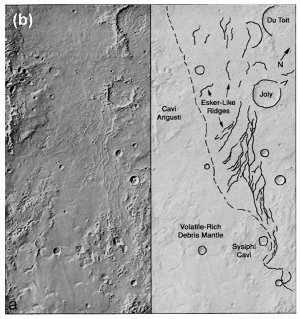Ice caps and glaciers on Mars today are “cold based,” meaning they are frozen solid to the ground beneath them. Scientists think the ice has been this way for most of the Amazonian period, the latest chapter in Mars’ geological history. It began roughly 3 billion years ago and continues today.

MEANDERING RIDGES in Dorsa Argentea trace the paths of streams that flowed under an ancient south polar ice sheet larger than the current one. (Image taken from Figure 1b in the paper.)
However, beyond the edge of the current south polar ice cap lies the Dorsa Argentea formation, which shows evidence for eskers. Well-known from terrestrial examples, eskers are low ridges made by streams that flow under glaciers, leaving deposits of rocks, gravel, and sand along their courses. When the ice disappears, the stream sediments are left standing above the surface as meandering ridges.
Dorsa Argentea’s eskers point up two facts: the polar cap was once more extensive, and the bottom of that ancient ice cap was warm enough for sub-glacial streams to flow.
These facts can provide clues to ancient climate, says a group of researchers led by glaciologist James Fastook (University of Maine). Writing in Icarus, the scientists noted that eskers require liquid water beneath the ice. Then they asked how much warmer the atmosphere needed to be to melt the base of ice cap. And similarly, how would the ice cap respond to the likely geothermal heat flow earlier in Martian history?
The team used two computer models, one for the atmosphere and climate, the other for the ice cap’s behavior. (They also assumed the ancient ice cap had a larger footprint to include Dorsa Argentea.)
The ice model showed that the geothermal heat flow back in Noachian and Hesperian times (from more than 4 billion years ago until about 3 billion years ago) was not high enough to melt the base of the ice cap. Thus the team’s “bottom up” hypothesis was unable to produce eskers.
But the atmospheric (“top down”) model produced a different result. Even when average temperatures remained well below freezing, the model showed the ice cap would seasonally produce small amounts of meltwater at the bottom of the ice cap. There it would accumulate until eventually it tunneled out, producing eskers.
The team says, “In order to produce significant basal melting at these typical geothermal heat fluxes, the mean annual south polar atmospheric temperatures must be raised from today’s -100° C [-148° F] to the range of -50° C to -75 °C [-58° F to -103° F].”
Looking more widely across Mars, they add that the warmer temperatures at the southern ice cap did not translate into a generally “warm and wet” early Mars for latitudes closer to the equator. While some melting would have occurred there, overall “the late Noachian climate of Mars may have been similar to the current hypothermal, hyperarid climate of the Antarctic Dry Valleys on Earth.”
In Antarctica, the team notes, “Seasonal melting leads to the formation of transient streams and ice-covered lakes that have similarities to the valley networks and open basin lakes on Mars.”








